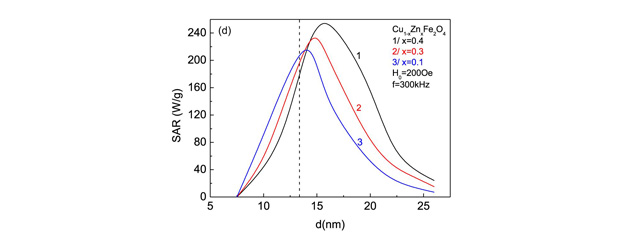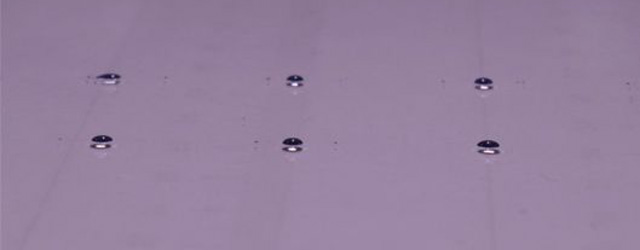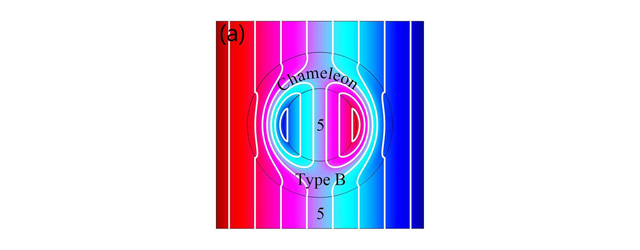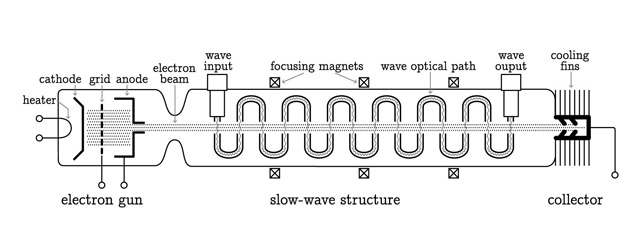Magnetic nanoparticles can 'burn' cancer cells (Vol. 50, No. 3)

Magnetic hyperthermia is still a highly experimental cancer treatment, but new research shows that the therapy is tunable.
Unfortunately, cancer isn’t simply a single disease, and some types, like pancreas, brain or liver tumours, are still difficult to treat with chemotherapy, radiation therapy or surgery, leading to low survival rates for patients. Thankfully, new therapies are emerging, like therapeutic hyperthermia, which heats tumours by firing nanoparticles into tumour cells. In a new study published recently, the authors show that tumour cells’ specific absorption rate of destructive heat depends on the diameter of the nanoparticles and the composition of the magnetic material used to deliver the heat to the tumour. The authors show that the tumour absorption rate greatly depends on the diameter of the nanoparticles. Surprisingly, the absorption rate increases as particle diameter increases, as long as the level of doping of the material is sufficiently high and the diameter doesn’t exceed a set maximum value (max. 14 nanometres for cobalt doping, 16 nm for copper).
A. Apostolov, I. Apostolova and J. Wesselinowa, Specific absorption rate in Zn-doped ferrites for self-controlled magnetic hyperthermia, Eur. Phys. J. B 92, 58 (2019)
[Abstract]
Optimising proton beam therapy with mathematical models (Vol. 50, No. 3)

Particle beam therapy is increasingly being used to treat many types of cancer. It consists in subjecting tumours to beams of high-energy charged particles such as protons. Although more targeted than conventional radiotherapy using X-rays, this approach still damages surrounding normal tissue. To design the optimum treatment plan for each patient, it is essential to know the energy of the beam and its effect on tumour and normal tissue alike. In a recent study, a group of researchers put forward a new mathematical model outlining the effects of these beam therapies on patients' tissues, based on new, more complex, parameters. Using these new models, clinicians should be able to predict the effect of proton beams on normal and tumour tissue more precisely, allowing them to prepare more effective treatment plans.
R. Abolfath, Y. Helo, L. Bronk, A. Carabe, D. Grosshans and R. Mohan, Renormalization of radiobiological response functions by energy loss fluctuations and complexities in chromosome aberration induction: deactivation theory for proton therapy from cells to tumor control. Eur. Phys. J. D 73, 64 (2019)
[Abstract]
Infinite number of quantum particles gives clues to big-picture behaviour at large scale (Vol. 50, No. 3)

Scientists gain a deeper understanding of phenomena at macroscopic scale by simulating the consequences of having an infinite number of physical phenomena at quantum scale.
In quantum mechanics, the Heisenberg uncertainty principle prevents an external observer from measuring both the position and speed (referred to as momentum) of a particle at the same time. They can only know with a high degree of certainty either one or the other—unlike what happens at large scales where both are known. To identify a given particle’s characteristics, physicists introduced the notion of quasi-distribution of position and momentum. This approach was an attempt to reconcile quantum-scale interpretation of what is happening in particles with the standard approach used to understand motion at normal scale, a field dubbed classical mechanics. In a new study published recently, the authors reverse this approach; starting with quantum mechanical rules, they explore how to derive an infinite number of quasi-distributions, to emulate the classical mechanics approach. This approach is also applicable to a number of other variables found in quantum-scale particles, including particle spin.
J. S. Ben-Benjamin, L. Cohen and M. O. Scully, From von Neumann to Wigner and beyond, Eur. Phys. J. Spec. Top. 227, 2171 (2019)
[Abstract]
Liquid jets break up more readily on a substrate (Vol. 50, No. 3)

Using computational models to investigate how liquid drops behave on surfaces
Whether we're aware of it or not, in day-to-day life we often witness an intriguing phenomenon: the breakup of jets of liquid into chains of droplets. It happens when it rains, for example, and it is important for inkjet printers. However, little is known about what happens when a liquid jet, also known as a liquid filament, breaks up on top of a substrate. According to a new study, the presence of a nearby surface changes the way the filament breaks up into smaller droplets. In a new paper published recently, computer simulations are used to show that a filament is more likely to break up near a surface. When a filament is broken into multiple droplets, the structure is unstable because surface tension means liquids tend to shrink to have the smallest-possible surface area.
A. Dziedzic, M. Nakrani, B. Ezra, M. Syed, S. Popinet, and S. Afkhami (2019), Breakup of finite-size liquid filaments: Transition from no-breakup to breakup including substrate effects, Eur. Phys. J. E 42 ,18 (2018)
[Abstract]
Geometry of quantum evolution in a nonequilibrium environment (Vol. 50, No. 3)

The geometric effect of quantum dynamical evolution has potential applications in studying quantum phase transition and realizing geometric quantum computation. Due to the fact that a quantum system unavoidably interacts with its environments and undergoes decoherence, much extensive attention has been paid to theoretical investigations on the geometric dynamical evolution in open quantum systems under nonunitary dynamics. The investigation on the geometry in the dynamical evolution of an open quantum system is crucial for further understanding the origins of decoherence, quantum-classical transition and so on.
There are many significant situations where the nonequilibrium feature of the environment becomes dominant. In these situations, the statistical properties of the environmental noise are nonstationary, corresponding physically to impulsively excited phonons of the environment in certain nonequilibrium states initially. We show that the renormalization of the intrinsic energy of the system, namely, the frequency shift induced by the nonequilibrium feature of the environment has a significant impact on the geometry of quantum dynamical evolution.
X. Cai, R. Men, Y. Zhang and L. Wang, Geometry of quantum evolution in a nonequilibrium environment, EPL 125, 30007 (2019)
[Abstract]
Correlated chaotic pressure modes in rapidly rotating stars (Vol. 50, No. 3)

Correlated chaotic pressure modes in rapidly rotating starsPressure oscillations in stars can be monitored through the Fourier analysis of luminosity curves, observed e.g. in recent and future space missions. Similarly to seismologists on Earth, astronomers use the oscillation modes of stars to access properties of their interiors. This method has been very successful for slowly rotating stars. For rapidly rotating stars, since the star is flattened by centrifugal acceleration, the acoustic ray dynamics is more complex, with both regular and chaotic zones in phase space. The authors study the properties of chaotic modes in the domain of high frequencies. The numerical simulations show that chaotic modes produce specific regularities in the oscillation spectra. This is at odds with the expected properties of chaotic modes, usually distributed like the eigenvalues of random matrices. Through a semiclassical theory, they link this peculiarity to the strong decrease of the sound speed near the star surface. Chaotic modes could contribute to the regularities observed in Scuti stars, attributed so far to regular modes. (Vol. 50, No. 3)
B. Evano, B. Georgeo and F. Lignières, Correlations in the chaotic spectrum of pressure modes in rapidly rotating stars, EPL 125, 49002 (2019)
[Abstract]
Shape stability of pasta phases (Vol. 50, No. 3)
Exotic non-spherical shapes of nuclear matter, so called pasta phases, are possible because of the competition between the short-ranged nuclear attraction and the long-ranged Coulomb repulsion, leading to the phenomenon of Coulomb frustration, well known in statistical mechanics. Such complex phases are expected in the inner crust of neutron stars, as well as in core-collapse supernova cores.
The authors of this work examine for the first time the stability of the « lasagna » phase, consisting of periodically placed slabs, by means of exact geometrical methods. Calculations are done in the framework of the compressible liquid drop model but obtained results are universal and do not depend on model parameters like surface tension and charge density. The stability analysis is done with respect to the different types of deformations corresponding to the eigenvalues of the deformation matrix.
Their compelling result is that this slab phase is locally stable in the whole density interval where pasta phases are present. Consequently, this specific phase could be present as a metastable structure in a larger density domain than previously expected, with potential important consequences on the resistivity of the crust and the cooling mechanism of neutron stars.
S. Kubis and W. Wócjik, Shape stability of pasta phases: Lasagna case, Eur. Phys. J. A 54, 215 (2018)
[Abstract]
Turbulence theory closer to high-energy physics than previously thought (Vol. 50, No. 3)

A new research paper finds the high-energy physics concept of 'un-naturalness' may be applicable to the study of turbulence or that of strongly correlated systems of elementary particles
Many scientists have been disappointed that no new elementary particles have been discovered at CERN's Large Hadron Collider in the wake of the Higgs boson discovery in 2012.The no-show of elusive particles that had previously been predicted by theory is only one example of a 'hole' that has recently appeared in the concept of Naturalness in theoretical physics. In simple terms, the concept states that physical parameters should depend roughly equally on all the terms used to calculate them, in terms of proportion. Sauro Succi, a theoretical physicist at the Fondazione Istituto Italiano di Tecnologia in Rome, Italy, has now published an intriguing essay in which he argues that several common natural phenomena do not operate under ‘Naturalness' at all. Rather, they can only be explained using parameters with widely separated numerical values.
S. Succi, Of Naturalness and Complexity, Eur. Phys. J. Plus 134, 97 (2019)
[Abstract]
Efficiently manipulating magnetism with a sputtered topological insulator (Vol. 50, No. 3)

The field of spintronics aims to efficiently control the magnetic state of magnetic material using electric currents for better magnetic memories. In this regard, the spin-orbit coupling (SOC) effect, which couples the orbital and spin degrees of the freedom of electrons, has received enormous research attention. The SOC provides a pathway to convert an electric current in a non-magnetic material to a spin current which can subsequently be utilized for fast and efficient control of a magnetic material.
Recently, the material topological insulator (TI) has gained research interest due to its exotic properties including high SOC effect. Although earlier works have utilized the SOC effect of TI to efficiently control the magnetization, the TI material was mostly grown using molecular beam epitaxy technique which is not common in the memory industry. In this work, the authors utilize the more common growth technique of sputtering to grow the TI material (Bismuth Selenide), which allows both the TI and the magnet to be grown in situ. Subsequently, the authors demonstrate a highly efficient switching of the magnetic information storage layer using the high SOC from the sputtered Bismuth Selenide.
R. Ramaswamy, T. Dutta, S. Liang, G. Yang, M. S. M. Saifullah, and H. Yang, J. Phys. D: Appl. Phys. 52, 224001 (2019)
Intelligent metamaterials behave like electrostatic chameleons (Vol. 50, No. 3)

A chameleon can flexibly change its colour to match its surroundings. And a similar phenomenon can now be seen in a new class of smart materials called metamaterials. The trouble is that these metamaterials lack the ability to respond to nearby objects due to their physical characteristics. To remedy this shortcoming, the authors have developed so-called 'metashells': hollow shells made of metamaterials and capable of carrying materials in their core. The advantage is that their physical characteristics, such as permittivity--the extent to which a material can store charge within an electrical field--change with the electromagnetic properties of the material they contain. In a theoretical study published recently, they describe how they have developed an entire class of these chameleon-like metashells. These intelligent metashells could become an all-purpose material to satisfy different permittivity requirements under different conditions. The next stages will focus on experimental research, and on industrial applications.
L. Xu and J. Huang, Electrostatic chameleons: Theory of intelligent metashells with adaptive response to inside objects, Eur. Phys. J. B 92, 53 (2019)
[Abstract]
Traveling-wave tubes: The unsung heroes of space exploration (Vol. 50, No. 3)

An invention from the 1950s is still being used today
What do televisions and space exploration have in common? No, we’re not talking about a cheesy physics joke; rather, this is the story of an often-overlooked piece of equipment that deserves a place in the annals of telecommunication history. Some would argue that the traveling-wave tube (TWT) has not received the recognition it deserves when it comes to the history of space travel and communications – until now. A group of researchers has published recently a work looking into the history of TWTs. This is the first time a paper aimed at the general public has described the vital role of this technology in various areas of development. The team collected and read hundreds of papers on the history and evolution of the traveling-wave tube. First introduced in the 1950s, a TWT is a relatively simple piece of equipment used for transmitting data across long distances, including the vast expanses of space.
D.F.G. Minenna, F. Andre, Y. Elskens, J.-F. Auboin, F. Doveil, J. Puech and E. Duverdier (2019), The traveling-wave tube in the history of telecommunication, Eur. Phys. J. H 44, 1 (2019)
[Abstract]
A Liquid-Lithium Target for Nuclear Physics (Vol. 50, No. 3)

A liquid-lithium target (LiLiT) bombarded by a 1.5 mA, 1.92 MeV proton beam from the SARAF superconducting linac acts as a ~30 keV quasi-Maxwellian neutron source via the 7Li(p,n) reaction with the highest intensity (5×1010 neutrons/s) available to date. We activate samples relevant to stellar nucleosynthesis by slow neutron capture (s-process). Activation products are detected by α, β or γ spectrometry or by direct atom counting (accelerator mass spectrometry, atom-trap trace analysis). The neutron capture cross sections, corrected for systematic effects using detailed simulations of neutron production and transport, lead to experimental astrophysical Maxwellian averaged cross sections (MACS). A parallel effort to develop a LiLiT-based neutron source for cancer therapy is ongoing, taking advantage of the neutron spectrum suitability for Boron Neutron Capture Therapy (BNCT) and the high neutron yield available.
M. Paul and 16 co-authors, Reactions along the astrophysical s-process path and prospects for neutron radiotherapy with the Liquid-Lithium Target (LiLiT) at the Soreq Applied Research Accelerator Facility (SARAF), Eur. Phys. J. A 55, 44 (2019)
[Abstract]
Exploiting Slow Light for Stimulated Brillouin Scattering (Vol. 50, No. 3)

Stimulated Brillouin scattering (SBS) is an important third-order nonlinear process. The main challenge of utilizing SBS in silicon photonic waveguides is that the SBS gain coefficient is too weak to generate efficient power conversion between optical waves and acoustic waves.
In a recent study, the authors show how to improve the SBS process in a periodic suspended silicon waveguide by exploiting the slow light characteristic. They focus on tuning the structural parameters and working wavelength of the device to exploiting the resonance enhancement effect to amplify the weak SBS phenomenon. The calculated SBS gain coefficient is shown to be in the order of 106 W-1m-1. They also prove the feasibility of the device design using standard silicon-on-insulator wafers. The slow-light waveguide provides a powerful platform for light-sound interaction through SBS process.
Y. Xu, L. Zhou, L. Lu, J. Chen, and B. M. A. Rahman, Enhanced forward stimulated Brillouin scattering in silicon photonic slot waveguide Bragg grating, J. Phys. D: Appl. Phys. 52, 184001 (2019)
[Abstract]






